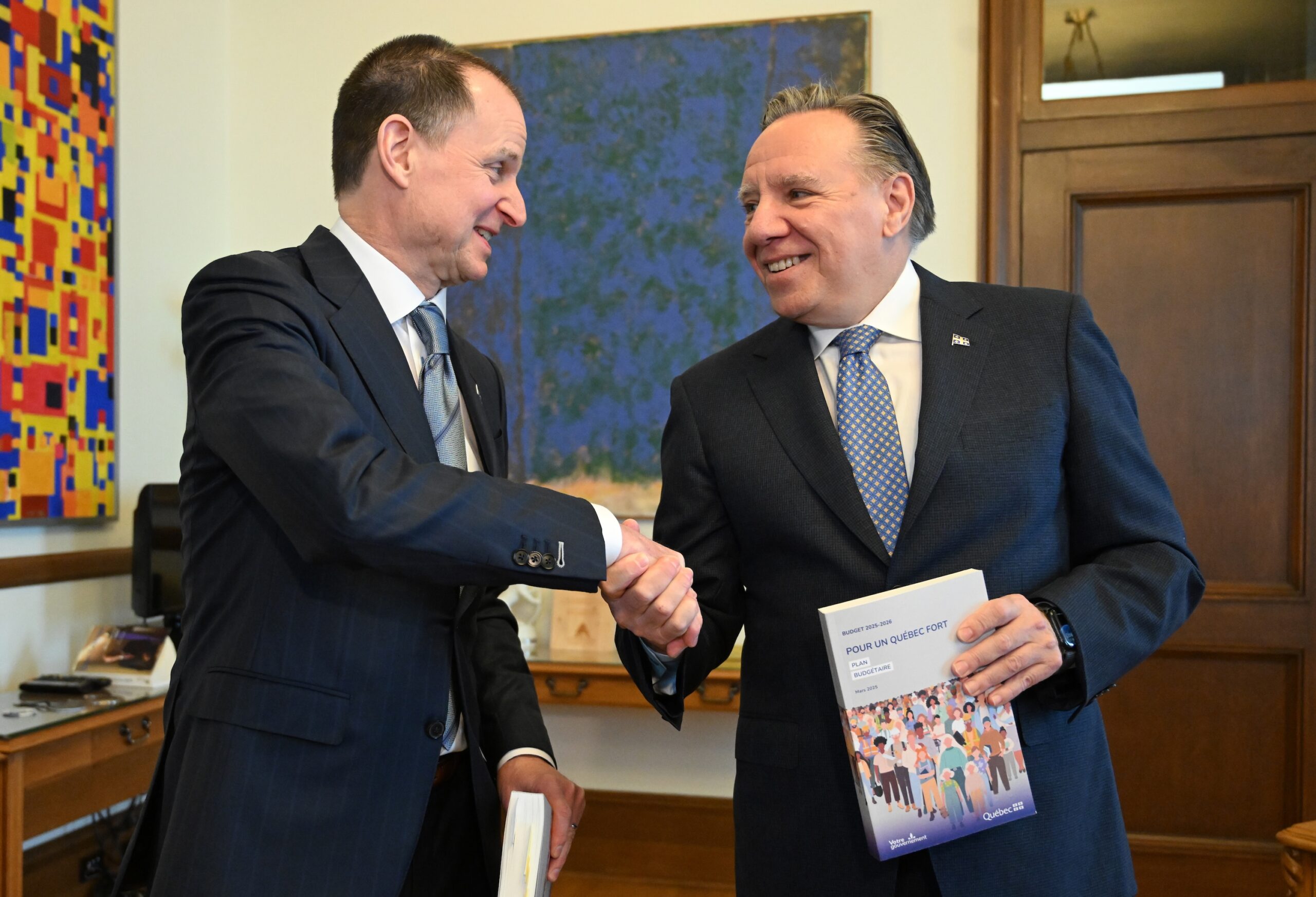On Tuesday March 25th, Québec Finance Minister Éric Girard tabled his seventh provincial budget in the National Assembly. Premier Francois Legault’s Coalition Avenir Québec (CAQ) government looked to address the worries of Quebecers; while balancing the economic uncertainties the provinces economy faces due to the threat of U.S. tariffs set to come into effect, as well as those already affecting one of the provinces largest sectors; aluminium.
To this end, Budget 2025-26 puts forward a number of new spending measures to address the tariff threat, provide support for innovation while revitalizing the Quebec economy to fit the needs of today and the future. It also provides a revised outlook for the upcoming fiscal years, which are the first to take into account the economic impact of tariffs. It is noted that Budget 2025-2026 is based on the premise that tariffs would be imposed by the U.S. on several trading partners, including Canada, and that while they could be adjusted in the coming months the government’s baseline assumption is that these tariffs would average the equivalent of 10% for a transitional period of around two years.
With that in mind, the government is projecting a deficit of $13.6 billion for 2025-26, which is up from the $9.2 billion projected by the minister in the 2024 fall economic statement. This marks a new high for the province, surpassing the previous $11 billion deficit recorded in the 2024-2025 budget. However, Minister Girard noted that the actual deficit expected for 2024-2025 will be slightly lower than expected.
In his speech given to the National Assembly, Minister Girard attributed Québec’s budgetary shortfall to a period of turbulence amid trade and diplomatic relations with the U.S. administration:
Today, Québec is facing a different challenge, and we have a responsibility to respond with strength. The new U.S. administration is threatening our economy by proposing protectionist measures, notably in the form of harmful and unjustified tariffs on Québec and Canadian products.”
— Québec Finance Minister Éric Girard
During his speech, Minister Girard also highlighted the government’s accomplishments, stating that Québec’s wealth gap with Ontario is expected to narrow to 9.9% in 2026, down from 15.9% in 2018 and that household purchasing power improved by 6.6% in the province, compared to 3.9% in the rest of Canada.
Major initiatives in the budget include:
- A 7% ($11 billion) increase of the Québec Infrastructure Plan
- $4.1 billion to support Québec’s economy by providing transitional assistance to businesses affected by U.S. tariffs, supporting the completion of investment projects and fostering market diversification.
- Specifically, $200 million in 2025-26 & 2026-27 will be available for transitional purposes.
- $3.9 billion for improving the delivery of healthcare and social services.
Key figures
- 2025-26 Budget Deficit – $13.6 billion.
- Deficit increase from 2024-25 to 2025-26 – $3.3 billion.
- Forecast 2026-27 Budget Deficit – $7.1 billion.
- Forecast 2027-28 Budget Deficit – $4.2 billion.
- 2024-25 Net Debt-to-GDP ratio – 38.7%
- Forecast 2025-26 Net Debt-to-GDP ratio – 40.4%
- Forecast 2026-27 Net Debt-to-GDP ratio– 41.5%
- 2024-25 Real GDP Growth – 1.4%
- Forecast 2025-26 Real GDP Growth – 1.1%
- Forecast 2026-27 Real GDP Growth – 1.4%
Economic outlook
The 2025-26 deficit comes in at $13.6 billion, or 2.2% of GDP. This is including the deposits required under the Balanced Budget Act of 2006 that requires investment into the Generations Fund which exclusively goes towards paying down Quebec’s provincial debt.
Revenue amounts are expected to total $156.3 billion in 2025-2026, which is an increase of 0.7%, year-over-year. While the government is projecting that growth will rebound in 2026-27 and increase to 5.7%. Over the years covered by the financial projections (until 2029-30), revenue growth is expected to average 3.2%. Total expenditures, which include debt servicing, stand at $165.8 billion in 2025-2026, which is an increase of 1.5% from 2024-25. This is lower than the expected growth in expenditures given the investments announced in this budget, which is expected to push them to 2.7% in 2026-2027.
Net debt as outlined by the budget stands at 40.4% of GDP, which is slightly lower than the pre-pandemic level of 40.9% in 2020. The net debt to GDP ratio is expected to increase steadily until 2027-28, with the government stating the significant investments in public infrastructure needed to stimulate economic growth in an uncertain environment is the main contributor to this increase. They expect the ratio to fall to 39.8% in 2030. The CAQ also noted that given these uncertain economic times, they will be adjusting their debt reduction targets that were announced in March 2023. The new targets now dictate that net debt to GDP must be reduced to 35.5% of GDP by 2032-2033 and to 32.5% of GDP by 2037-2038. Debt servicing costs will come in at $9.7 billion for this fiscal year.
In addition, a large contributor to this budget’s bottom line is the inclusion of a contingency reserve of $2.0 billion in 2025-2026 and 2026-2027, and $1.5 billion per year as of 2027-2028, for a total of $8.5 billion over five years that are to be used in case of more moderate-than-anticipated economic growth.
Reinforcing and revitalizing the economy
Budget 2025-26 looks to invest $5.4 billion over five years to stimulate wealth creation, as another way to combat the uncertainty of U.S. tariffs. To this end, the government will allocate $4.1 billion to provide assistance to businesses affected by the tariffs, support investment projects and foster market diversification. This also comes in the form of providing financial assistance through loans for affected businesses, offering liquidity support of up to $1.6 billion. The government is setting aside $400 million over two years for this initiative.
To support these investment initiatives, budget 2025-26 includes $3.5 billion over five years, directed at continuing the digital transformation offensive, the construction training offensive, supporting Québec suppliers in the electrical industry and ensuring optimal timeframes for environmental authorizations for economic projects.
Another $759 million will be dedicated to revitalizing regional economies, leveraging critical minerals, supporting the forestry and tourism industries, as well as the development of the bio-food sector.
Infrastructure will play a significant role in the government’s upcoming decisions, as they take the time to explain that not only does it help deliver services to residents, but it also is an effective way at stimulating economic growth in times of uncertainty and improves Quebec’s long-term economic potential. This is why Budget 2025-26 announces plans to increase the Quebec Infrastructure Plan (QIP) over the next 10-years, by $11 billion, or 7%, bringing the total investment up to $164 billion. The government outlines that significant amounts will be invested to maintain assets and improve infrastructure in health care, education, higher education, transportation, and significant investments in social housing.
The government has also committed another $604.1 million to increasing the province’s capacity for innovation by modernizing public services for greater efficiency, through an updated tax assistance system with the introduction of the tax credit for research, innovation and commercialization (CRIC). The CRIC will replace eight tax measures currently in effect and will provide additional financial support totalling $271.5 million over five years.
Other efforts to improve the tax system will free up nearly $3 billion over five years. These measures will impact the tax credit for the development of e-business, refocusing on higher value-added IT activities and the development of e-businesses integrating artificial intelligence.
The government has also signalled its intention to adjust its tax incentive approach towards critical and strategic mineral companies. While currently the government offers incentives covering part of companies’ exploratory costs, they want to expand the provinces’ economy into the processing, development and recycling sector. To do this, they plan on adjusting the existing tax assistance and enhancing its availability for these critical and strategic minerals, while maintaining competitiveness for other resources. They also plan on making mineral resource development expenses eligible for assistant, while introducing a ceiling to ensure fair distribution of the assistance. To ensure this fair distribution, particularly during an expansion cycle, a cumulative ceiling on eligible expenses of $100 million per five-year period will be introduced.
Revitalizing social services
The CAQ has dedicated more than $6.8 billion to fund health and social services between now and 2029-2030. Of this amount, nearly $5.0 billion is dedicated to funding the delivery, accessibility and quality of healthcare and social services across the province. To do this, the government is committing $2.2 million over five years, to fund pharmaceutical treatments in hospitals, deploy new facilities, accelerate the digital shift of the RAMQ and training of more doctors.
With its focus on increasing support for young people fighting homelessness, the government is investing more than $1 billion to increase support for housing services, fund community organizations, consolidate psychosocial interventions and community policing efforts and to provide support for Indigenous clienteles. The government is also allocating $302.6 million to improve housing conditions, including maintaining low-rental housing and housing adaptations and urgent housing needs. Seniors and their living environment are another focus of the government, with dedicated funding to harmonize public and private CHSLDs and protecting them in private seniors’ residences.
Another $1.1 billion was set aside to foster educational success, training new teachers, promoting participation in sports and access to childcare services, building on the school retention initiatives from budget 2024-25.
Looking ahead
Opposition parties were quick to vocalize about their opinions on Girard’s Budget. Parti Québécois Leader Paul St-Pierre-Plamondon said the government was using the trade war with U.S. as a scapegoat to cover up some of the government’s missteps, including its failed investment in Northvolt and SAAQclic which cost over $1 billion. Liberal finance critic Frédéric Beauchemin commented that the CAQ consistently produces larger than expected deficits, all the while allowing the degradation of social services in the province.
With the next provincial election approaching in fall 2026, Finance Minister Éric Girard will face an extended period of challenging political and economic environments as he and Premier François Legault attempt to convince Quebecers that they remain the best choice to lead the province. As seen in this budget—and provincial budgets produced across the country in the past number of weeks—the uncertainties created by the Canada – U.S. trade relationship pose an existential threat to the current reality of economic planning.
Additional links
- Budget 2025-2026 (Ministère des Finances)
- Budget in Brief – Priorities: Health, Education (Ministère des Finances)
- Budget Speech (Ministère des Finances)
- Budget by the numbers – March 2025 (Ministère des Finances)
- Budget 2025-2026 Supplementary Information (Ministère des Finances)
- Québec’s Economic and Financial Summary (Ministère des Finances)
Insights for this piece provided by Bailey Stafford, Daniel Bernier, Delaney Cullinan, and Victoria LaChance.


